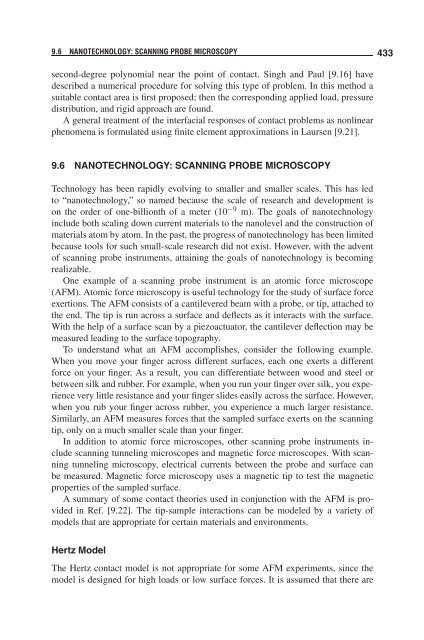9 Contact Stresses
9 Contact Stresses
9 Contact Stresses
Create successful ePaper yourself
Turn your PDF publications into a flip-book with our unique Google optimized e-Paper software.
9.6 NANOTECHNOLOGY: SCANNING PROBE MICROSCOPY 433<br />
second-degree polynomial near the point of contact. Singh and Paul [9.16] have<br />
described a numerical procedure for solving this type of problem. In this method a<br />
suitable contact area is first proposed; then the corresponding applied load, pressure<br />
distribution, and rigid approach are found.<br />
A general treatment of the interfacial responses of contact problems as nonlinear<br />
phenomena is formulated using finite element approximations in Laursen [9.21].<br />
9.6 NANOTECHNOLOGY: SCANNING PROBE MICROSCOPY<br />
Technology has been rapidly evolving to smaller and smaller scales. This has led<br />
to “nanotechnology,” so named because the scale of research and development is<br />
on the order of one-billionth of a meter (10 −9 m). The goals of nanotechnology<br />
include both scaling down current materials to the nanolevel and the construction of<br />
materials atom by atom. In the past, the progress of nanotechnology has been limited<br />
because tools for such small-scale research did not exist. However, with the advent<br />
of scanning probe instruments, attaining the goals of nanotechnology is becoming<br />
realizable.<br />
One example of a scanning probe instrument is an atomic force microscope<br />
(AFM). Atomic force microscopy is useful technology for the study of surface force<br />
exertions. The AFM consists of a cantilevered beam with a probe, or tip, attached to<br />
the end. The tip is run across a surface and deflects as it interacts with the surface.<br />
With the help of a surface scan by a piezoactuator, the cantilever deflection may be<br />
measured leading to the surface topography.<br />
To understand what an AFM accomplishes, consider the following example.<br />
When you move your finger across different surfaces, each one exerts a different<br />
force on your finger. As a result, you can differentiate between wood and steel or<br />
between silk and rubber. For example, when you run your finger over silk, you experience<br />
very little resistance and your finger slides easily across the surface. However,<br />
when you rub your finger across rubber, you experience a much larger resistance.<br />
Similarly, an AFM measures forces that the sampled surface exerts on the scanning<br />
tip, only on a much smaller scale than your finger.<br />
In addition to atomic force microscopes, other scanning probe instruments include<br />
scanning tunneling microscopes and magnetic force microscopes. With scanning<br />
tunneling microscopy, electrical currents between the probe and surface can<br />
be measured. Magnetic force microscopy uses a magnetic tip to test the magnetic<br />
properties of the sampled surface.<br />
A summary of some contact theories used in conjunction with the AFM is provided<br />
in Ref. [9.22]. The tip-sample interactions can be modeled by a variety of<br />
models that are appropriate for certain materials and environments.<br />
Hertz Model<br />
The Hertz contact model is not appropriate for some AFM experiments, since the<br />
model is designed for high loads or low surface forces. It is assumed that there are
















